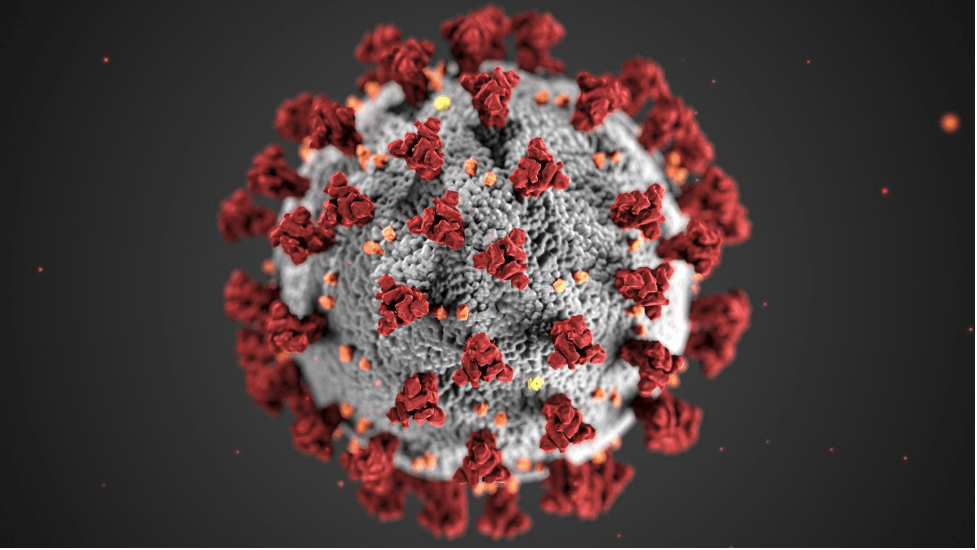Rori Stuart ‘22, Biological Sciences, Winter 2021
Figure 1. The image above shows a three–dimensional rendering of the SARS-CoV-2 virus, with the spike proteins clearly visible in red and the viral envelope in grey.
(Source: pxhere.com)
Around the start of 2020, a novel coronavirus began to spread around the world from its origins in Wuhan, China. As the year progressed, lockdowns ensued, international travel was inhibited, and economies around the world slowed (Taylor 2020). Almost a year into the pandemic, another strain of the COVID-19 virus was identified in the UK. This strain, called B.1.17, was found by the Covid-19 Genomics UK (COG-UK) Consortium in late 2020 and has since begun spreading around the world at a disconcertingly quick rate (COG-UK 2020; The Center for Disease Control accessed 2021). The origin of B.1.1.7 was hypothesized to be an infected individual, with the virus mutating within this person before spreading to others (COG-UK 2020).
The new variant of SARS-CoV-2 has 17 mutations, with 14 replacements and 3 deletions (COG-UK 2020). These mutations are not wholly unique to B.1.17, but they can still be considered cause for concern. One of the mutations, N501Y, for example, can be found in South African variants of the virus and improves the virus’ ability to bind to cells (Reardon 2020). Another mutation, D614G has also been found in other American viral strains and increases the virus’ ability to infect the upper respiratory tract (Reardon 2020). While this does suggest that transmissibility via coughing and sneezing may increase, there is no definitive evidence for this as of yet (Reardon 2020). However, it is known that the new strain is 70% more transmissive than the original strain, accounting for its high prevalence in the southeast of England (COG-UK 2020; The Center for Disease Control accessed 2021).
The two mutations mentioned earlier, N501Y and D614G, are both located near the spike protein of SARS-CoV-2, alongside six other mutations as well. The mutations appear to be located near the region where antibodies attach to the virus, potentially making antibody treatments less effective (Reardon 2020). Research into the COVID-19 virus suggests that one mutation can resist Regeneron’s antibody cocktail, REGN-COV2; however, this experiment is awaiting peer-review (Starr et al. 2020). As of now, there are no known virus variants that can resist the vaccines currently available, including the B.1.1.7 strain, so the vaccines produced by Moderna and Pfizer are likely to be effective (Reardon 2020). This new strain may not cause a resurgence in the coronavirus cases globally, but the identification of new strains in the United Kingdom, as well as South Africa and Nigeria, are nonetheless concerning.
References
COG-UK. (2020). “COG-UK update on SARS-CoV-2 Spike mutations of special interest report 1.” Covid-19 Genomics UK Consortium. https://www.cogconsortium.uk/wp-content/uploads/2020/12/Report-1_COG-UK_20-December-2020_SARS-CoV-2-Mutations_final_updated2.pdf
“New COVID-19 Variants.”(2021).The Center for Disease Control. https://www.cdc.gov/coronavirus/2019-ncov/transmission/variant.html
Reardon, S. (2020). “The U.K. Coronavirus Mutation Is Worrying but Not Terrifying.” Scientific American. https://www.scientificamerican.com/article/the-u-k-coronavirus-mutation-is-worrying-but-not-terrifying/
Starr, T. N., Greaney, A. J., Addetia, A., Hannon, W. H., Choudhary, M. C., Dingens, A. S., Jonathan Z. L. and Bloom, J. D. (2020).“Prospective mapping of viral mutations that escape antibodies used to treat COVID-19.” bioRxiv. https://www.biorxiv.org/content/10.1101/2020.11.30.405472v1.full.pdf
Taylor, D. B. (2020). “A Timeline of the Coronavirus Pandemic.” The New York Times. https://www.nytimes.com/article/coronavirus-timeline.html


Leave a Reply